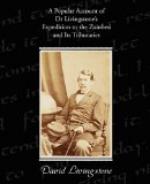Villages, as usual encircled by euphorbia hedges, were numerous, and a great deal of grain had been cultivated around them. Domestic fowls, in plenty, and pigeons with dovecots like those in Egypt were seen. The people call themselves Matumboka, but the only difference between them and the rest of the Manganja is in the mode of tattooing the face. Their language is the same. Their distinctive mark consists of four tattooed lines diverging from the point between the eyebrows, which, in frowning, the muscles form into a furrow. The other lines of tattooing, as in all Manganja, run in long seams, which crossing each other at certain angles form a great number of triangular spaces on the breast, back, arms, and thighs. The cuticle is divided by a knife, and the edges of the incision are drawn apart till the true skin appears. By a repetition of this process, lines of raised cicatrices are formed, which are thought to give beauty, no matter how much pain the fashion gives.
It would not be worth while to advert for a moment to the routine of travelling, or the little difficulties that beset every one who attempts to penetrate into a new country, were it not to show the great source of the power here possessed by slave-traders. We needed help in carrying our goods, while our men were ill, though still able to march. When we had settled with others for hire, we were often told, that the dealers in men had taken possession of some, and had taken them away altogether. Other things led us to believe that the slave-traders carry matters with a high hand; and no wonder, for the possession of gunpowder gives them almost absolute power. The mode by which tribes armed with bows and arrows carry on warfare, or defend themselves, is by ambuscade. They never come out in open fight, but wait for the enemy ensconced behind trees, or in the long grass of the country, and shoot at him unawares. Consequently, if men come against them with firearms, when, as is usually the case, the long grass is all burned off, the tribe attacked are as helpless as a wooden ship, possessing only signal guns, would be before an iron-clad steamer. The time of year selected for this kind of warfare is nearly always that in which the grass is actually burnt off, or is so dry as readily to take fire. The dry grass in Africa looks more like ripe English wheat late in the autumn, than anything else we can compare it to. Let us imagine an English village standing in a field of this sort, bounded only by the horizon, and enemies setting fire to a line of a mile or two, by running along with bunches of burning straw in their hands, touching here and there the inflammable material,—the wind blowing towards the doomed village—the inhabitants with only one or two old muskets, but ten to one no powder,—the long line of flames, leaping thirty feet into the air with dense masses of black smoke—and pieces of charred grass falling down in showers. Would not the stoutest English villager, armed only with the bow and arrow against the enemy’s musket, quail at the idea of breaking through that wall of fire? When at a distance, we once saw a scene like this, and had the charred grass, literally as thick as flakes of black snow, falling around us, there was no difficulty in understanding the secret of the slave-trader’s power.




